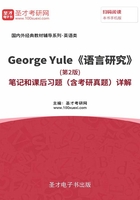
第6章 语音模式
6.1 复习笔记
音位学(phonology)主要描述语音系统和模式。但是,音位学不是研究发音的物理过程和特征,而是研究语音的抽象特征或心理特征。
本章要点:
1.Phonology 音位学
2.Phonemes, phones, and allophones 音位、音素和音位变体
3.Minimal pairs and sets 最小对立体和最小对立集
4.Rules of array 序列规则
5.Phonotactics 音位结构学
6.Syllables and clusters 音节和丛
7.Co-articulation effects 协同发音作用
8.Assimilation and Elision 同化和音节省略
本章考点:
音位学;音位、音素和音位变体;最小对立体和最小对立集,音位结构学,音节和音丛;序列规则,音位与音位变体的区别,辅音丛,协同发音、同化、音节省略的定义及辨识。
本章内容索引:
I. Phonology
1.Definition
2.Explanation
II. Phonemes
1.Definition
2.The token of phoneme
3.The contrastive property of phoneme
III. Phones and allophones
1.Phones
2.Allophones
IV. Minimal pairs and sets
1.Minimal pairs
2.Minimal sets
V. Phonotactics
1.Definition
2.Syllables and clusters
3.Rules of array
VI. Co-articulation effects
1.The definition of co-articulation effects
2.Assimilation
3.Elision
I. Phonology(音位学)
【考点】音位学的定义
1.Definition(定义)
Phonology is the study of the systems and patterns of speech sounds in a language.
音位学主要是研究语言中的语音系统及模式。
2.Explanation(解释)
①Phonology is concerned with the abstract or mental aspect of the sounds in language rather than with the actual physical articulation of speech sounds.
②Phonology serves as the constant basis of all the variations in different physical articulations of that sound type in different contexts.
①音位学主要是关于语言中语音的抽象的或心理方面的内容,而不是实际的发音。
②音位学构成了所有变体在各种语境中不同发音的基础。
II.Phonemes(音位)
【考点】音位的定义,音位的辨音
1.Definition(定义)
Phoneme is the smallest meaning-distinguishing sound unit in the abstract representation of the sounds of a language.
音位是对语音抽象的表示,是能够区别意义的最小的语音单位。
2.The contrastive property of phoneme(音位的对比性特征)
①An essential property of a phoneme is that it functions contrastively.
②There are ‘features’ which distinguish each phoneme from the next.
①音位最根本的特征是它具有对比性功能。
②每个音位都有自己的音位特征,使之与其他音位相区别。
III. Phones and allophones(音素和音位变体)
【考点】音素和音位变体的定义,音位与音位变体的区别,音素和音位的区别
1.Phones(音素)
(1) Definition(定义)
The phoneme is the abstract unit or sound-type. Phones are different versions of that sound-type regularly produced in actual speech.
一个抽象的音位可能有若干个不同的发音方式,这些发音叫做音素。
(2) The distinction between phones and phonemes(音素与音位的区别)
Phones do not necessarily distinguish meaning. But a phoneme is a unit that is of distinctive value. It is not any particular sound, but rather it is represented or realized by a certain phone in a certain phonetic context.
音素不一定能区别意义,但音位是具有区别意义的单位。音位不是指某个具体的语音,而是通过音素在语音语境中得以表现出来。
2.Allophones(音位变体)
(1) Definition(定义)
The phones that can represent a phoneme in certain phonetic context are called its allophones.
同一个音位在不同的语音环境中的各种音素称为该音位的音位变体。
(2) Distinction between phonemes and allophones(音位和音位变体的区别)
The crucial distinction between phonemes and allophones is that substituting one phoneme for another will result in a word with a different meaning (as well as a different pronunciation), but substituting allophones only results in a different (and perhaps odd) pronunciation of the same word.
音位和音位变体的主要区别在于用一种音位替换另一种音位会导致单词的意思发生改变(发音也会改变),但是替换音位变体,单词不变,发音会改变(可能会显得有些怪异)。
IV. Minimal pairs and sets(最小对立体和最小对立集)
【考点】最小对立体和最小对立集的定义及区分
1.Minimal pairs(最小对立体)
Minimal pairs are two words which are identical in every way except for one sound segment that occurs in the same place in the string.
最小对立体指的是两个单词除了一个语音片段之外其余部分完全相同的状态,这种能区别不同音位的成对单词叫最小对立体。
2.Minimal sets(最小对立集)
When a group of words can be differentiated, each one from the others, by changing one phoneme (always in the same position), then we have a minimal set.
只在同一个语音位置上有差别的成组单词叫做最小对立集。
V. Phonotactics(音位结构学)
【考点】音位结构学、音节和丛的定义;序列规则
1.Definition(定义)
Phonotactics studies constrains that govern possible sequences or positions of phonemes.
音位结构学研究的是限制音位可能的顺序或位置的规则。
2.Syllables and clusters(音节和音丛)
(1) Syllable(音节)
A syllable must contain a vowel (or vowel-like) sound. The most common type of syllable in language also has a consonant before the vowel, often represented as CV.
①Onset: one or more consonants.
②Rime (also written as “rhyme”): consists of the vowel, which is treated as the nucleus, plus any following consonant(s), treated as the coda.

一个音节必然包括一个元音(或类似元音的音)。语言中最常见一种的音节是,在元音前有一个辅音,通常表示为CV。
①音节头:一个或多个辅音。
②韵脚:包括元音(被称为“音节核”)和后面的辅音(被称做“音节尾”)。
(2) Consonant cluster (CC)(辅音丛)
Both the onset and the coda can consist of more than one consonant, also known as a consonant cluster (CC).
音节头和音节尾可以由多个辅音组成,也被称作辅音丛。
(3) Three consonants (CCC)(三个辅音的辅音丛)
English actually can have larger onset clusters, as in stress and splat, consisting of three consonants (CCC).
英语中还有更大的辅音丛,例如在单词stress和splat中,就有三个辅音组成的辅音丛。
3.Rules of array(序列规则)
The first consonant must always be /s/, followed by one of the voiceless stops (/p/, /t/, /k/) and then one of the approximants (/r/,/1/,/w/).
第一音位必须是/s/。第二个音位必须是/p/或/t/或/k/。第三个音位必须是/1/或/r/或/w/。
VI. Co-articulation effects(协同发音作用)
【考点】协同发音、同化、音节省略的定义及辨识
1.Definition of co-articulation(协同发音的定义)
The process of making one sound almost at the same time as the next is called co-articulation. There are two well-known co-articulation effects, called “assimilation” and “elision”.
当涉及到这种同时或重合的发音时,我们称之为协同发音。主要包括“同化”和“省略”现象。
2.Assimilation(同化)
When two phonemes occur in sequence and some aspect of one phoneme is taken or “copied” by the other, the process is known as assimilation.
在音位序列中,一个音位的某个特征被另一个音位复制或吸收的过程称作同化。
3.Elision(省音)
The “omission” of a sound segment which would be present in the deliberate pronunciation of a word in isolation is technically described as elision.
省音是指省略音节之间或词与词之间的音素,是快速语流中的自然现象。